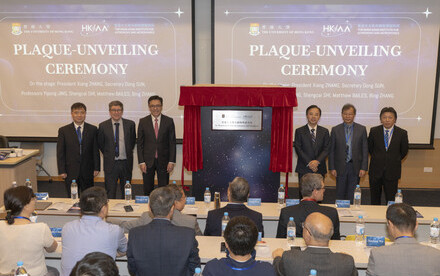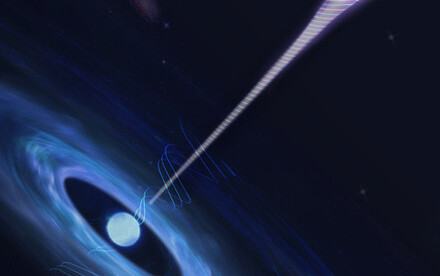25 Aug 2025
High Resolution Radio Observations Reveal Mysteries of the Cosmic Hand

Credit: X-ray: NASA/CXC/Univ. of Hong Kong/S. Zhang et al.; Radio: ATNF/CSIRO/ATCA; H-alpha: UK STFC/Royal Observatory Edinburgh; Image Processing: NASA/CXC/SAO/N. Wolk)
An international astrophysics team led by Professor Stephen NG from the Department of Physics has captured the most detailed radio view of the famous “Cosmic Hand” nebula, MSH 15-52, using the Australia Telescope Compact Array (ATCA).
This nebula spans across 150 light-years and is powered by energetic particles from the central pulsar B1509-58, an ultra-dense neutron star formed in a supernova explosion when a massive star ended its life about two thousand years ago.
In X-ray images, the nebula has an uncanny resemblance to a human hand, complete with a palm, a thumb, and fingers (see Fig. 1). Scientists had long assumed that the energetic particles fueling this X-ray glow would also produce a radio image with a similar shape. But the new radio observations tell a very different story.
‘Many prominent features of the X-ray nebula are not found in radio, including the strong jet towards the bottom, the pair of arcs surrounding the central pulsar, and the three upward-pointing fingers,’ explained Shumeng ZHANG, lead author of the paper and a PhD student at the Department of Physics at HKU (see Figs. 2 and 3). ‘This could represent different populations of particles with the most energetic ones leaking out from the jet and fingers.’
Instead, the high-resolution radio data reveal a complex network of intricate filaments in the nebula and a highly ordered magnetic field that orients along the filaments.
‘These are likely resulting from complicated interplay between the pulsar particles and the surrounding supernova’s debris,’ explained Professor Ng, ’but further simulation works are needed to confirm this and to investigate the detailed formation history of this peculiar system.’
Moreover, this new study discovers that the associated supernova remnant RCW 89 in the north (see Fig. 4) is rather unique among its kind. Its radio emission is patchy and closely follows the clumps in optical and X-ray bands. It also extends significantly beyond the supernova blast wave seen in X-rays. All these support the idea that the supernova shock wave is colliding with a dense hydrogen cloud.
Fig. 1: X-ray image of the Cosmic Hand nebula (called MSH 15-52), showing the most dramatic features: a luminous jet and linear structure that resemble the palm and fingers. Image credit: NASA/CXC/Univ. of Hong Kong/S. Zhang et al.; Image Processing: NASA/CXC/SAO/N. Wolk | Fig 2: High resolution radio view of the Cosmic Hand, showing surprisingly different structure than the X-ray image. Image credit: ATNF/CSIRO/ATCA/Univ. of Hong Kong/S. Zhang et al.; Image Processing: NASA/CXC/SAO/N. Wolk |
Fig 3: Composite view of the “Cosmic Hand” nebula MSH 15-52. The radio data are shown in red, X-rays are shown in blue, orange, and yellow, and an optical image of hydrogen gas is in gold. Image credit: X-ray: NASA/CXC/Univ. of Hong Kong/S. Zhang et al.; Radio: ATNF/CSIRO/ATCA; H-alpha: UK STFC/Royal Observatory Edinburgh; Image Processing: NASA/CXC/SAO/N. Wolk | Fig 4: Same as Fig. 3, with different parts of the Cosmic Hand nebula labeled. Image credit: X-ray: NASA/CXC/Univ. of Hong Kong/S. Zhang et al.; Radio: ATNF/CSIRO/ATCA; H-alpha: UK STFC/Royal Observatory Edinburgh; Image Processing: NASA/CXC/SAO/N. Wolk |
The study has been published in The Astrophysical Journal (2025) vol 989, p. 221.
More images can be found here.











